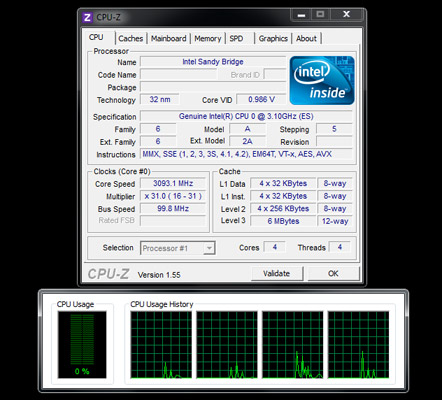The Sandy Bridge Preview
by Anand Lal Shimpi on August 27, 2010 2:38 PM ESTThe Test
As was the case with Lynnfield, the current Sandy Bridge CPUs Intel is sampling are slightly different than what will be sold. The Core i5 2400 runs at 3.1GHz, has four cores, 6MB of L3 cache but no Hyper Threading. In order to help Intel’s partners test HT functionality however, the i5 2400s being sampled right now have Hyper Threading enabled. For the purposes of our test I’ve run with HT both enabled (to give you an idea of higher end SB parts) and disabled (to give you an idea of i5 2400 performance).
The other major difference between what’s out today and what’s coming in Q1 is turbo. Early Sandy Bridge samples, ours included, do not have turbo enabled. The CPU simply runs at 3.1GHz all the time, regardless of workload. The final retail 2400 will be able to run at up to 3.4GHz.
In other words, what we show here should be indicative of final performance, but it's probably slower than what will ship in Q1.
On the GPU side, the part I’m testing appears to be the single-core GPU configuration (6 EUs). Intel hasn’t released any info as to what parts will get the dual-core/12 EUs GPU configurations, although it may make sense for Intel to use the 12 EU parts in notebooks given the importance of integrated graphics to the mobile market. Update: The part we're looking at may actually have been a lower clocked 12 EU part, we're still waiting for additional confirmation.
Our test platform was a H67 based motherboard running with 4GB of DDR3-1333, the same memory we use in our Lynnfield testbeds.
I’m comparing to four other CPUs. The Core i7 980X for a high end comparison, the Core i7 880 for a near clock-for-clock comparison (albeit with HT enabled), the Core i5 760 for a potential price comparison and the Phenom II X6 1090T. The latter should be AMD’s fastest offering (if not close to it) when Sandy Bridge ships. Update: Note the Core i5 650 is actually the predecessor to the Core i5 2400, however I didn't feel a dual core vs. quad core comparison was too fair. The i5 760 will actually go head to head with the higher clocked i5 2500 when it launches in Q1.
| Motherboard: |
ASUS P7H57DV- EVO (Intel H57) Intel DP55KG (Intel P55) Intel DX58SO (Intel X58) Intel DX48BT2 (Intel X48) Gigabyte GA-MA790FX-UD5P (AMD 790FX) |
| Chipset Drivers: |
Intel 9.1.1.1015 (Intel) AMD Catalyst 8.12 |
| Hard Disk: | Intel X25-M SSD (80GB) |
| Memory: |
Corsair DDR3-1333 4 x 1GB (7-7-7-20) Corsair DDR3-1333 2 x 2GB (7-7-7-20) |
| Video Card: |
eVGA GeForce GTX 280 (Vista 64) ATI Radeon HD 5870 (Windows 7) |
| Video Drivers: |
ATI Catalyst 9.12 (Windows 7) NVIDIA ForceWare 180.43 (Vista64) NVIDIA ForceWare 178.24 (Vista32) |
| Desktop Resolution: | 1920 x 1200 |
| OS: |
Windows Vista Ultimate 32-bit (for SYSMark) Windows Vista Ultimate 64-bit Windows 7 x64 |











200 Comments
View All Comments
tech6 - Friday, August 27, 2010 - link
More speed with less power - it looks like a very competitive product. I really hope that AMD has something up their sleeve with Bulldozer and Bobcat to compete with Sandy Bridge.killless - Friday, August 27, 2010 - link
17% higher performance is just not exciting.You need to give me 50% improvement at least to make me want to spend $1000 for new CPU/Motherboard/memory.
It really hasn't been all that exciting since Core 2 Quad...
tatertot - Friday, August 27, 2010 - link
I take it turbo was also disabled on the rest of the parts used to compare, right?Anand Lal Shimpi - Friday, August 27, 2010 - link
Turbo was enabled on everything else - SB performance should be higher for final parts.Take care,
Anand
tatertot - Friday, August 27, 2010 - link
Oh!Well that puts the IPC gains of Sandy over Westmere at something like 20% then, considering the 880 turbos up to 3.73GHz on single-threaded work.
That's pretty impressive.
Drag0nFire - Friday, August 27, 2010 - link
I just want to say first of all, this totally made my Friday! I love previews of upcoming architectures!Any news on the roadmap for the mobile variant of Sandy Bridge? Or do I have to wait til IDF?
Jamahl - Friday, August 27, 2010 - link
What system was this benchmarked on Anand?Anand Lal Shimpi - Friday, August 27, 2010 - link
Clarkdale - those charts were actually pulled from here, just with the SB numbers added:http://www.anandtech.com/show/2952/2
We didn't have the system for long enough to rerun the tests with the 5450 on the H67 board. The 5450 is GPU bound at those resolutions/settings however:
http://images.anandtech.com/graphs/5450_0203102236...
Those numbers were generated with a Core i7 920.
Take care,
Anand
Anand Lal Shimpi - Friday, August 27, 2010 - link
I just ran a sanity check on the Core i7 880 with the 5450, the numbers don't move by more than the normal test margins - the 5450 is totally GPU bound here.Take care,
Anand
ESetter - Friday, August 27, 2010 - link
Do you know if any of the benchmarks make use of AVX instructions? Sandy Bridge effectively doubles the maximum throughput for compute-intensive operations like SGEMM and DGEMM. While it might not translate to a 2x speedup in real-world applications, I imagine it should give a significant gain, at least in the HPC field.